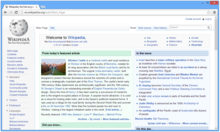Web browser

A web browser (also referred to as an Internet browser or simply a browser) is application software for accessing the World Wide Web or a local website. When a user requests a web page from a particular website, the web browser retrieves the necessary content from a web server and then displays the page on the user's device.
A web browser is not the same thing as a search engine, though the two are often confused.[1][2] A search engine is a website that provides links to other websites. However, to connect to a website's server and display its web pages, a user must have a web browser installed.[3]
Web browsers are used on a range of devices, including desktops, laptops, tablets, and smartphones. In 2020, an estimated 4.9 billion people used a browser.[4] The most used browser is Google Chrome, with a 63% global market share on all devices, followed by Safari with 20%.[5]
In Hypertext Transfer Protocol technical texts, web browsers (and other clients) are commonly referred as user agents.
Function
The purpose of a web browser is to fetch content from the Web or from a local storage device and display it on a user's device.
This process begins when the user inputs a Uniform Resource Locator (URL), such as https://en.wikipedia.org/, into the browser. Virtually all URLs on the Web start with either http: or https: which means the browser will retrieve them with the Hypertext Transfer Protocol (HTTP). In the case of secure mode (HTTPS), the communication between the browser and the web server is encrypted for the purposes of security and privacy.
Once a web page has been retrieved, the browser's rendering engine displays it on the user's device. This includes image and video formats supported by the browser. Many web browsers can display partial content, while the retrieval is still in progress, providing more responsive behavior, especially on slower network connections.
Web pages usually contain hyperlinks to other pages and resources. Each link contains a URL, and when it is clicked or tapped, the browser navigates to the new resource. Thus the process of bringing content to the user begins again.
Most browsers use an internal cache of web page resources to improve loading times for subsequent visits to the same page. The cache can store many items, such as large images, so they do not need to be downloaded from the server again.[6] Cached items are usually only stored for as long as the web server stipulates in its HTTP response messages.[7]
Settings
Web browsers can typically be configured with a built-in menu. Depending on the browser, the menu may be named Settings, Options, or Preferences.
The menu has different types of settings. For example, users can change their homepage and default search engine. They also can change default web page colors and fonts. Various network connectivity and privacy settings are also usually available.
Privacy
During the course of browsing, cookies received from various websites are stored by the browser. Some of them contain login credentials or site preferences.[8] However, others are used for tracking user behavior over long periods of time, so browsers typically provide a section in the menu for deleting cookies.[8] Finer-grained management of cookies usually requires a browser extension.[9]
Browsers also usually provide menu items for deleting browsing history, cache entries, and other potentially sensitive data.
An alternative approach is the private browsing mode, in which the aforementioned items are not stored by the browser. But this is a temporary option, only activated when using this special mode.
Features
The most popular browsers have a number of features in common. They automatically log browsing history or can be used in a non-logging private mode. They also allow users to set bookmarks, customize the browser with extensions, and can manage user passwords.[10] Some provide a sync service and web accessibility features.

Most browsers have these user interface (UI) features:
- Allow the user to open multiple pages at the same time, either in different browser windows or in different tabs of the same window.
- Back and forward buttons to go back to the previous page visited or forward to the next one.
- A refresh or reload and a stop button to reload and cancel loading the current page. (In most browsers, the stop button is merged with the reload button.)
- A home button to return to the user's home page.
- An address bar to input the URL of a page and display it, and a search bar to input terms into a search engine. (In most browsers, the search bar is merged with the address bar.)
While mobile browsers have similar UI features as desktop versions, the limitations of touch screens require mobile UIs to be simpler.[11] The difference is significant for users accustomed to keyboard shortcuts.[12] The most popular desktop browsers also have sophisticated web development tools.
Besides the common usage of graphical browsers, there are niche text-based and headless types of browsers.
Security
Web browsers are popular targets for hackers, who exploit security holes to steal information, destroy files, and other malicious activities. Browser vendors regularly patch these security holes, so users are strongly encouraged to keep their browser software updated. Other protection measures are antivirus software and avoiding known-malicious websites.[13]
History
The first web browser, called WorldWideWeb, was created in 1990 by Sir Tim Berners-Lee.[14][15] He then recruited Nicola Pellow to write the Line Mode Browser, which displayed web pages on dumb terminals.[16]

1993 was a landmark year with the release of Mosaic, credited as "the world's first popular browser".[17] Its innovative graphical user interface made the World Wide Web system easy to use and thus more accessible to the average person. This, in turn, sparked the Internet boom of the 1990s, when the Web grew at a very rapid rate.[17] Marc Andreessen, the leader of the Mosaic team, soon started his own company, Netscape, which released the Mosaic-influenced Netscape Navigator in 1994. Navigator quickly became the most popular browser.[18]
Microsoft debuted Internet Explorer in 1995, leading to a browser war with Netscape. Within a few years, Microsoft gained a dominant position in the browser market for two reasons: it bundled Internet Explorer with its popular Windows operating system and did so as freeware with no restrictions on usage. The market share of Internet Explorer peaked at over 95% in the early 2000s.[19]
In 1998, Netscape launched what would become the Mozilla Foundation to create a new browser using the open source software model. This work evolved into the Firefox browser, first released by Mozilla in 2004. Firefox market share peaked at 32% in 2010.[20]
Apple released its Safari browser in 2003. Safari remains the dominant browser on Apple devices, though it did not become popular elsewhere.[21]
Google debuted its Chrome browser in 2008, which steadily took market share from Internet Explorer and became the most popular browser in 2012.[22][23] Chrome has remained dominant ever since.
Microsoft released its Edge browser in 2015 as part of the Windows 10 release. (Internet Explorer is still used on older versions of Windows.[24])
Since the early 2000s, browsers have greatly expanded their HTML, CSS, JavaScript, and multimedia capabilities. One reason has been to enable more sophisticated websites, such as web apps. Another factor is the significant increase of broadband connectivity, which enables people to access data-intensive content, such as YouTube streaming, that was not possible during the era of dial-up modems.
Market share
See also
References
- ^ What is a Browser?. Google (on YouTube). 30 April 2009. Archived from the original on 11 December 2021.
Less than 8% of people who were interviewed on this day knew what a browser was.
- ^ "What is the difference between the internet, browsers, search engines and websites?". Mozilla. 17 June 2021.
Let's start by breaking down the differences between the internet, browsers, search engine, and websites. Lots of us get these four things confused with each other.
- ^ "Difference Between Search Engine and Browser".
- ^ "World Internet Users Statistics and 2019 World Population Stats". www.internetworldstats.com. Retrieved 11 November 2019.
- ^ "Current browser market share". StatCounter. Retrieved 29 October 2021.
- ^ "Definition of browser cache". PC Magazine.
- ^ Fountis, Yorgos (4 May 2017). "How does the browser cache work?". Retrieved 19 February 2020.
- ^ a b "Tracking Cookies: What They Are, and How They Threaten Your Privacy". Tom's Guide. 16 September 2013. Retrieved 11 March 2019.
- ^ "Alternatives to Cookie AutoDelete extension". AlternativeTo. Retrieved 11 March 2019.
- ^ Balaban, David (17 February 2021). "Password Manager Comparison: Top Password Managers for 2021". eWEEK. Retrieved 4 November 2021.
- ^ Lee, Simon (29 March 2019). "The Limitations Of Touch Interfaces". Glance. Retrieved 23 April 2021.
- ^ "Chrome keyboard shortcuts". Google Inc. Retrieved 23 April 2021.
- ^ "Securing Your Web Browser". www.us-cert.gov. Retrieved 21 April 2019.
- ^ "Tim Berners-Lee: WorldWideWeb, the first Web client". World Wide Web Consortium.
- ^ Stewart, William. "Web Browser History". Archived from the original on 20 January 2011.
- ^ Gillies, James; Cailliau, R. (2000). How the Web was Born: The Story of the World Wide Web. Oxford University Press. pp. 6. ISBN 0192862073.
{{cite book}}: CS1 maint: multiple names: authors list (link) - ^ a b "Bloomberg Game Changers: Marc Andreessen". Bloomberg. 17 March 2011. Retrieved 7 December 2011.
- ^ Enzer, Larry (31 August 2018). "The Evolution of the Web Browsers". Monmouth Web Developers. Retrieved 31 August 2018.
- ^ Baker, Loren (24 November 2004). "Mozilla Firefox Internet Browser Market Share Gains to 7.4%". Search Engine Journal.
- ^ Routley, Nick (20 January 2020). "Internet Browser Market Share (1996–2019)". Visual Capitalist. Retrieved 4 November 2021.
- ^ "Internet Explorer usage to plummet below 50 percent by mid-2012" (JPEG). Digital Trends. 3 September 2011.
- ^ "StatCounter April-May 2012 data". Retrieved 8 May 2021.
- ^ Blog, Windows Experience (19 May 2021). "The future of Internet Explorer on Windows 10 is in Microsoft Edge". Windows Experience Blog. Retrieved 4 November 2021.
- ^ "Desktop Browser Market Share Worldwide". Net Applications.
External links
 Media related to Web browsers at Wikimedia Commons
Media related to Web browsers at Wikimedia Commons
